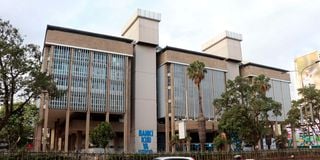Banks draw Sh33bn CBK loans in just two months

The Central Bank of Kenya headquarters in Nairobi.
What you need to know:
- The average interbank lending rate stood at 13.76 percent on Thursday.
- In August last year, the CBK brought interventions to the interbank window.
Commercial banks have tapped Sh32.7 billion from the Central Bank of Kenya (CBK) discount window in the first two months of this year, pointing to liquidity woes facing the lenders.
The drawings in January and February are in contrast to a similar window of last year when they did not tap a single cent from the CBK facility and show liquidity strains currently facing banks.
The CBK runs a “discount window” from which banks can tap funds as a last resort after exhausting all other avenues, including borrowing from one another.
Transactions here occur through reverse repos which are commonly used by the CBK to advance short-term capital to other businesses during cash flow challenges.
Reverse repos involve the purchase of government securities by the Central Bank from commercial banks.
CBK emergency loans
Banks also have the option to borrow from one another in the inter-bank market — a network used by financial institutions to extend loans to one another over a specified period.
Kenya Bankers Association (KBA) chief executive officer, Habil Olaka said the increased use of the CBK emergency loans is due to the lack of adequate liquidity in the interbank market where lending rates are moving closer to the ceiling, set at 2.5 per cent above the current benchmark lending rate.
The average interbank lending rate stood at 13.76 percent on Thursday, easing from 14 per cent last week.
“When the interbank rates are moving towards the upper end of the interest corridor, it means that the market is tight and thereby CBK needs to introduce liquidity in the market. When liquidity is not introduced, banks have to seek alternatives and you see a number of banks falling back to the window,” Mr Olaka said.
Benchmark lending rate
The prevailing lending conditions in the interbank market are attributable in part to the tightening of monetary policy by the CBK with the current benchmark lending rate sitting at a 12-year high of 13 per cent.
Borrowings from the CBK discount window attract a premium of four percent above the prevailing benchmark interest rate which currently rounds off to 17 per cent.
The punitive cost of accessing the window has nevertheless failed to deter banks as borrowing in the interbank market sees headwinds of inadequate liquidity and market segmentation where lenders in lower tiers often lack access to funding from larger banks.
In August last year, the CBK brought interventions to the interbank window to improve liquidity including the introduction of an interbank interest rate window around the benchmark lending rate or central bank rate (CBR) at 2.5 percentage points above, or below the rate.





